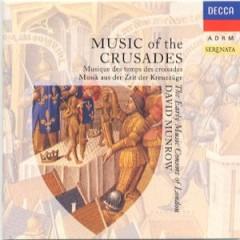Music of the Crusades (1991)
Music of the Crusades (1991)

1 Anon., French 13th century: La quinte estampie reale 2 Marcabru: Pax in nomine Domini! 3 Anon., French: Parti de mal 4 Anon., French: Chevalier, mult estes guariz 5 Guiot de Dijon: Chanterai por mon corage 6 Anon., French 13th century: Danse Real 7 Anon., French: Sede, Syon, in pulvere 8 Walther von der Vogelweide: Palästinalied 9 Anon., French 13th century: Condicio - O nacio - Mane prima 10 Anon., French: O tocius Asie 11 Anon., French 13th century: La uitime estampie reale 12 Anon., French: Cum sint difficilia 13 Le Châtelain de Coucy: Li noviaus tens 14 Gaucelm Faidit: Fortz chausa es 15 Anon., French 13th century: Je ne puis - Amors me tienent - Veritatem 16 Conon de Béthune: Ahi! Amours 17 Anon., French 13th century: La tierche estampie reale 18 Richard Coeur de Lion: Ja nus hons pris 19 Thibaut de Champagne: Au tens plain de felonnie Christina Clarke (soprano) James Bowman (countertenor) Charles Brett (countertenor) Nigel Rogers (tenor) Geoffrey Shaw (baritone) David Munrow (recorder, flute, shawn, crumhorn & bagpipes) Eleanor Sloan (treble rebec) Oliver Brookes (bass rebec) James Tyler (lute & citole) Gillian Reid (bells) Christopher Hogwood (harp, organ, nakers & tabor) James Blades (nakers & tabor)
This disc features vocal and instrumental music pertaining to the crusades, and the performers are the Early Music Concert of London under the directorship of David Munrow. This easily one of the best period instrument ensembles from the second half of the 20th century, and the clearly know what they are doing. Though the music is never inelegant, it often does have overtones of an entrenched martial resolve. This is not the music of moderate times, but it is not bloodthirsty either. Meditative, gorgeous melodies are part of the programme, as are works featuring aggressive percussion and a direct, unconquerable sound. The diversity of the disc is one of its strengths. Many of the works are by unknown or anonymous composers, but they all from 12th-13th centuries, ascribing to the troubadour tradition, from the few manuscripts that survived that period. Apart from the stellar musicians, this recording also features five singers of comparable merit, and no shortcomings among them can be detected after several hearings. Enthusiastic, painstaking research as obviously gone into the performance practice in operation here, and the delivery is genuinely inspired. Readers interested in becoming familiar with this sort of material will be especially satisfied with this recording, made in 1970 with excellent sound. ---John Keillor, Rovi
download: uploaded yandex 4shared mediafire solidfiles mega zalivalka filecloudio anonfiles oboom








